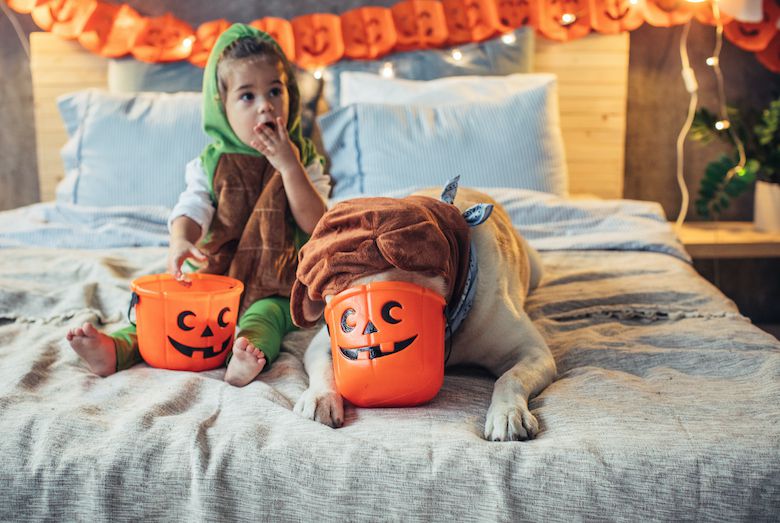[ad_1]
Most of us have heard that chocolate is not good for dogs, but just how bad is it? And what happens if dogs eat chocolate? It actually depends on how much and what type of chocolate a dog eats. (Yes, some types of chocolate are actually worse for dogs than others.) Read on to find out everything you need to know about dogs and chocolate toxicity.
Contents
1. Methylxanthines are the real reasons for chocolate poisoning in dogs.
Two substances found in cacao (chocolate’s main ingredient) called methylxanthines (theobromine and caffeine) are to blame for dogs and chocolate toxicity. On that note, anything containing caffeine is also toxic to dogs, including coffee (especially beans and grounds), tea (especially tea bags), energy drinks, soda and over-the-counter caffeine pills.
2. Some types of chocolate are worse for dogs than others.
Different types of chocolate contain different levels of theobromine and caffeine. The more concentrated the chocolate product, the more actual chocolate it contains and the more dangerous it is for dogs to consume. “Baking chocolate is the worst,” says Scott Fausel, medical director of VCA Sinking Spring in Sinking Spring, Pennsylvania. “Things that are just chocolate sweetened like brownies are usually less intensely toxic.”
Types of chocolate from most (the worst chocolate for dogs) to least toxic for dogs are as follows:
- Unsweetened dry cocoa powder
- Baking chocolate
- Dark chocolate (above 60 percent cacao)
- Semi-sweet/bittersweet chocolate
- Milk chocolate
- White chocolate (white chocolate is not a problem as it contains none of the dangerous methylxanthines found in true chocolate products)
3. The amount of chocolate your dog consumes plays a part.
Small dogs are affected by smaller amounts of chocolate than large dogs. For instance, a 50-pound Lab will probably be fine even if he eats an entire Hershey’s milk chocolate bar, but if a Chihuahua ate that same milk chocolate bar, she could be in trouble. That said, you should always call your vet or a poison-control hotline if your dog ever consumes any type of chocolate, even if you just think your dog might have eaten chocolate. “If in doubt, better to have the pet checked out,” Dr. Fausel advises. “Typically, the veterinary hospital will treat the pet for the potential toxin if there is a suspicion.
4. Yes, dogs and chocolate can be a fatal combination.
The theobromine and caffeine in chocolate can cause serious cardiovascular problems. “Rapid heart rate can then lead to abnormal heart rhythms, which in the worse-case scenario can even lead to the heart failing to beat properly and death,” Dr. Fausel explains. “It can also lead to neurologic signs. You might notice the pet being jittery, possibly with tremors, or just acting very restless, anxious and more excited than normal.”
5. If your dog eats chocolate, time is of the essence.
“The first thing to do would be to call either a local or emergency veterinary clinic, or if you have a number to a poison-control center for pets, call that number directly and try to get an idea from those folks what action you need to take,” Dr. Fausel says. Note that charges apply when calling poison-control hotlines.. The most known one is the ASPCA Animal Poison Control’s Center Phone Number, which is 888-426-4435. You can call 24 hours a day, every day of the year. According to the ASPCA, it’s important that you collect the evidence — any remaining packaging from the chocolate candy or treats so you can your veterinarian or the poison control center know:
• What type of chocolate it was
• How much chocolate was eaten
• What kind of filling, if any, was in the chocolate (fillings like raisins or macadamia nuts are also toxic)
Looking for a chart on how much chocolate is toxic to dogs? Check out Dogster’s sister publication Whole Dog Journal’s chart: How Much Chocolate is Toxic to Dogs: Theobromine Toxic Dosages.
6. Your vet might make your dog throw it all up.
If not too much time has passed since your dog ingested the chocolate, the vet might induce vomiting to get as much out as possible, then administer activated charcoal, which absorbs the toxins so they can be expelled from the body. “The patient will typically be given intravenous fluid therapy at a fairly high rate to try to increase the rapidity of the elimination of the chocolate,” Dr. Fausel explains.
7. With quick treatment, most dogs will survive after eating chocolate.
“As long as it’s caught at the earlier stages almost all patients will survive even fairly large ingestions,” Dr. Fausel says.
8. Chocolate is also bad for cats.
Cats however, rarely try to consume chocolate. Felines don’t usually seek out sugary treats since they lack the taste receptors for sweet things.
Thumbnail: Photography by Liliya Kulianionak / Shutterstock.
Read more about dogs and chocolate on Dogster.com:
[ad_2]

